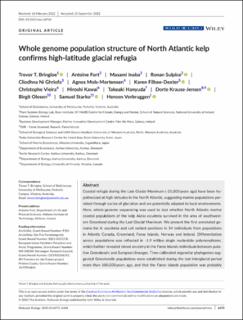| dc.description.abstract | Coastal refugia during the Last Glacial Maximum (~21,000 years ago) have been hypothesized at high latitudes in the North Atlantic, suggesting marine populations persisted through cycles of glaciation and are potentially adapted to local environments. Here, whole-genome sequencing was used to test whether North Atlantic marine coastal populations of the kelp Alaria esculenta survived in the area of southwestern Greenland during the Last Glacial Maximum. We present the first annotated genome for A. esculenta and call variant positions in 54 individuals from populations in Atlantic Canada, Greenland, Faroe Islands, Norway and Ireland. Differentiation across populations was reflected in ~1.9 million single nucleotide polymorphisms, which further revealed mixed ancestry in the Faroe Islands individuals between putative Greenlandic and European lineages. Time-calibrated organellar phylogenies suggested Greenlandic populations were established during the last interglacial period more than 100,000 years ago, and that the Faroe Islands population was probably established following the Last Glacial Maximum. Patterns in population statistics, including nucleotide diversity, minor allele frequencies, heterozygosity and linkage disequilibrium decay, nonetheless suggested glaciation reduced Canadian Atlantic and Greenlandic populations to small effective sizes during the most recent glaciation. Functional differentiation was further reflected in exon read coverage, which revealed expansions unique to Greenland in 337 exons representing 162 genes, and a modest degree of exon loss (103 exons from 56 genes). Altogether, our genomic results provide strong evidence that A. esculenta populations were resilient to past climatic fluctuations related to glaciations and that high-latitude populations are potentially already adapted to local conditions as a result. | en_US |
